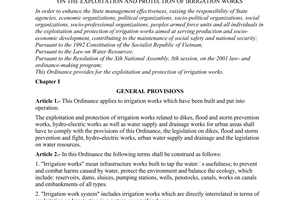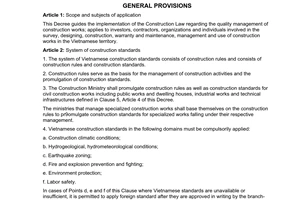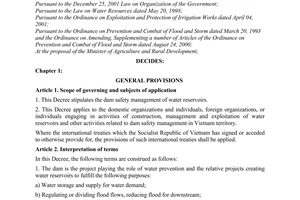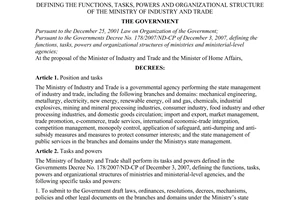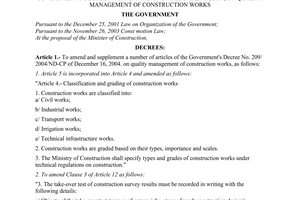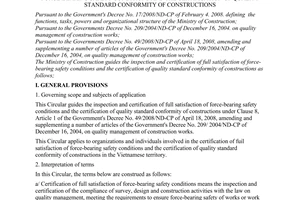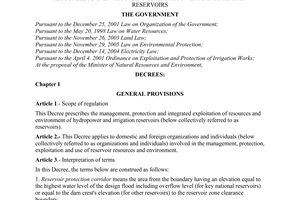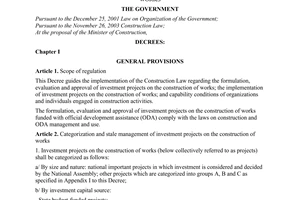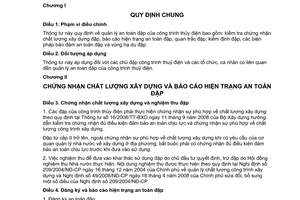Nội dung toàn văn Circular No. 34/2010/TT-BCT regulations on hydroelectric dam safety management
|
MINISTRY
OF INDUSTRY AND TRADE |
SOCIALIST
REPUBLIC OF VIETNAM |
|
No.: 34/2010/TT-BCT |
Hanoi, October 07, 2010 |
CIRCULAR
REGULATIONS ON HYDROELECTRIC DAM SAFETY MANAGEMENT
Pursuant to the Government's Decree No. 189/2007/NĐ-CP on December 27, 2007 on defining the functions, tasks, powers and organizational structure of the Ministry of Industry and Trade; Pursuant to the Decree No. 72/2007/NĐ-CP dated May 07, 2007 of the Government on dam safety management; Pursuant to the Government’s Decree No. 112/2008/NĐ-CP dated October 20, 2008 on management, protection and exploitation of natural resources and environment of hydroelectric and irrigation reservoirs; the Ministry of Industry and Trade regulates hydroelectric dam safety management as follows:
Chapter I
GENERAL PROVISIONS
Article 1. Governing scope
This Circular regulates hydroelectric dam safety management including inspection and certification of dam construction quality, reports on dam safety conditions, dam monitoring and assessment, measures to ensure safety to dam and dam lowlands.
Article 2. Regulated entities
This Circular applies to owners of hydroelectric works, agencies and organizations relating to hydroelectric dam safety management.
Chapter II
CERTIFICATION OF DAM CONSTRUCTION QUALITY AND REPORTS ON DAM SAFETY CONDITIONS
Article 3. Certification of dam construction quality and acceptance
1. Hydroelectric dams must undergo certification of construction quality conformity as stipulated in the Ministry of Construction’s Circular No. 16/2008/TT-BXD dated September 11, 2008 providing guidance on the inspection and certification of satisfaction of load bearing safety conditions and certification of construction quality conformity.
Any hydroelectric dam from grade II and over, in addition to certification of construction quality conformity as requested by state agencies in charge of construction, must be granted to a certificate of satisfaction of load bearing conditions before being put into operation.
2. Inspection, acceptance and putting into operation with respect to a hydroelectric dam shall be decided by the investor except dams undertaken by the state board of inspection and acceptance Inspection shall be done according to the Government’s Decree No. 209/2004/NĐ-CP dated December 16, 2004 on construction quality control and the Decree No. 49/2008/NĐ-CP dated April 18, 2008 amending and supplementing a number of articles of the Decree No. 209/2004/NĐ-CP.
Article 4. Registering and reporting dam safety conditions
1. Registering dam safety
Dam owners shall carry out the registration of dam safety with the Service of Industry and Trade within 30 days since the works is accepted and put into operation, and at the same time make submission of the dam safety declaration form to the Service of Agriculture and Rural Development.
Specimen dam safety declaration form is prescribed in the Appendix 3 enclosed herewith.
2. Reporting dam safety conditions
Annually, dam owners shall prepare a report on dam safety conditions and make submission of the report to the Service of Industry and Trade and the Service of Agriculture and Rural Development; for any hydroelectric reservoir with storage capacity from 10,000,000 m3 and over, in addition to reporting to the Service of Industry and Trade and the Service of Agriculture and Rural Development, dam owners must make a report to The Ministry of Industry and Trade (Industrial Safety Techniques and Environment Agency) for monitoring and management according to the law. Content and period of reporting are prescribed in Article 16 of the Decree No. 72/2007/ NĐ-CP.
Specimen dam safety condition report is prescribed in the Appendix 1 enclosed herewith.
Chapter III
DAM AND RELATED HYDROGRAPHIC FACTORS MONITORING
Article 5. Dam monitoring
1. Dam owners shall carry out observing, recording and storing monitored parameters installed at the dam and collect related meteorological and hydrographic information according to applicable regulations; update information about water flow to the Works.
2. During the period when flooding usually takes place, water level of upper and lower dam must be monitored as follows:
a) For reservoirs with free flood spillway
- When water level is lower than threshold of spilling: observing 4 times per day;
- When water level is equal or higher than threshold of spilling: observing 1 time per hour;
- When water level is one meter lower than surcharge pool: observing 4 times per day;
b) For reservoirs with controlled spillway
When water level is one meter lower than surcharge pool: observing 4 times per day;
3. Designing and installing instrumentation to monitor parameters such as seepage flows, piezometric levels, water levels, deformations or movements, pressures, loading conditions, stresses, temperature variations…shall be done according to Vietnam’s standards TCVN 8215:2009: Major regulations on engineering and installation of monitoring equipment of water head works.
Chapter IV
DAM SAFETY ASSESSMENT
Article 6. Qualifications of organizations and individuals that perform assessment of dam safety
1. Organizations, individuals that perform assessment of dams must obtain certificates of hydroelectric works assessment, consulting and engineering according to the law.
2. Meet all the conditions as prescribed in Article 36 of the Decree No. 12/2009/NĐ-CP dated February 12, 2009 on construction project management; Articles 4 and 5 of the Circular No. 22/2009/TT-BXD dated July 06, 2009 detailing qualifications for construction activities.
Article 7. Cycle of assessment
1. The first assessment shall be done in the second year since the first reservoir filling until the water reaches normal level.
2. For any hydroelectric reservoir with storage capacity of over 10,000,000 m3, the assessment of dams must be carried out every ten years and under since the most recent assessment according to the provisions set out in Article 8 hereof.
3. For any hydroelectric reservoir with storage capacity of below 10,000,000 m3, the assessment of dams must be carried out every seven years and under since the most recent assessment according to the provisions set out in Clause 1, Clause 5, Article 8 hereof.
Article 8. Content of assessment
1. Assessment of dam management performance
a) Implementation of hydroelectric dam operation process approved by the competent agency;
b) Implementation of water-gate operation process (if any), water intake; records of dam valve operation and trial operation processes;
c) Monitoring, collection and storage of documents concerning meteorological and hydrographic parameters in the reservoir valley; seepage, leakage on dam body, dam foundation, dam shoulder, dam displacements, cracks, landslide at dam body, foundation and area in the proximity to the works; accumulation of mud, sediments…in the reservoir;
d) Implementation of regulations on care and maintenance for each works, components of the works and equipment relating to dam safety;
dd) Inspection of dams: regular inspections; periodical inspections before and after flooding seasons; unregular inspection, detailed study of dams;
e) Restoration, repair and upgrading of dams;
2. Inspection and analysis of dam measurement and monitoring materials ;
a) Collection of data on measurements and monitoring of dams, works at head routes, energy routes from the construction and operation to the reporting on assessment;
b) Making the lists of monitoring instruments installed, quantity, working or failure conditions, period of repair work, restoration, evaluation of measurement method and its reliability, cycle of measurement;
c) Analysis and assessment of data of measurements and monitoring of dams at each monitoring point; monitoring data is expressed in the form of tables and charts. Based on that, carry out analysis and assessment of working conditions of the Works, make forecasts about development trend of movements (vertical, horizontal...), key effects on monitoring values when there is sudden change to measurements;
d) Formation of saturation line actually measured and assessed in comparison with design saturation line with respect to earth dams, rock-filled dams; assessment of foundation seepage pressure with respect to concrete dams;
dd) Based on dam monitoring data since the construction phase or most recent assessment, evaluate dam safety conditions and make forecasts about dam safety reduction level (if any);
e) Proposals on the monitoring and measuring tasks in the coming time such as equipment, additional monitoring points (form of monitoring, quantity), repairs and restoration of reliability of existing measurement equipment, cycle of measurement.
3. Inspecting and assessing dam safety quality
a) Carry out calculations to inspect dam stability corresponding to normal rising level, surcharge water level and other cases in conformity with the provisions on construction design;
b) Carry out calculations to inspect dams or structural components of the Works with conditions showing signs of abrupt, abnormal change based on the results of monitoring dam seepage and displacements, or dams are seriously damaged, or such damages previously existed and are getting worse;
c) Propose measures to intensify stability and safety to the Works;
4. Inspect accumulation of mud, sediments...to the reservoir
a) Carry out analysis and assessment of accumulation conditions of the reservoir based on the monitoring and measuring data in the past; distribute accumulation according to accumulation monitoring cross-sections on the reservoir; make forecasts about accumulation and life of the reservoir;
b) Carry out analysis and assessment of the causes of increasing or decreasing amount of alluvium in the reservoir;
c) Propose cycle of measuring and monitoring accumulation at reservoir bed: Quantity and positions of accumulation measuring and monitoring lines;
5. Carry out calculations of flooding and flood spilling capacity according to current dam design and meteorological and hydrographic documents, and updated changes to topography, geomorphology;
a) Collect and supplement meteorological and hydrographic data, changes to topography, geomorphology, level of covering of vegetation on the reservoir valley since the engineering phase, or from the most recent assessment to the formation of dam safety assessment report;
b) Carry out calculations to re-inspect flows of design flood and reference flood (including flood model, crest flood discharge and total flood discharge), update meteorological and hydrological monitoring data during the period of operation;
c) Carry out calculations to inspect flood spillway capacity versus the assessed flows of design flood, reference flood;
6. Assess flood prevention capacity of the Works;
7. Organizations and individuals shall establish a detailed report and be responsible to the law for results of assessment;
Article 9. Implementation of dam safety assessment
1. Dam owner shall select an organization or individual that performs assessment to carry out the assessment of dam safety according to the provisions set out in Articles 7, 8 hereof.
2. Dam owner shall establish and make submission to the Service of Industry and Trade the assessment result report enclosed with the assessment report prepared by the organization or agency that performs assessment; For any hydroelectric reservoir with water storage capacity from 10,000,000m3 and over, in addition to the submission of the report to the Service of Industry and Trade, the dam owner must also submit the assessment result report to the Industrial Safety Techniques and Environment Agency (affiliated to The Ministry of Industry and Trade) for follow-up and management according to the law.
Form of dam safety assessment report is shown in the Appendix 2 enclosed herewith;
3. Expenses for the implementation of dam safety assessment incurred by dam owner.
Chapter V
ENSURING SAFETY FOR DAM AND DAM LOWLANDS
Article 10. Operation process of hydroelectric reservoirs
1. The process of operation is prepared in accordance with the Prime Minister’s Decision No. 285/2006/QĐ-TTg dated December 25, 2006 on powers to promulgate and organize the implementation of operation process of hydroelectric reservoirs and make submission to competent authorities for approval before a reservoir is filled.
2. Powers to approve operation process of hydroelectric reservoirs
a) The Ministry of Industry and Trade shall approve the operation process of hydroelectric reservoirs with storage capacity from 1 million m3 and over or of the reservoir that lies on an administrative division of at least two provinces except that the operation process of multi-reservoirs shall be carried out in accordance with Article 12 of the Government’s Decree No. 112/2008/NĐ-CP dated October 20, 2008 on management, protection and exploitation of natural resources and environment of hydroelectric and irrigation reservoirs;
b) The People’s Committees of provinces shall approve operation process of the remaining hydroelectric reservoirs in the administrative division.
3. Regulation of reservoir water must comply with the provisions set out in the approved Operation Process.
4. Trial operation of dam valve-gates
a) Dry run test of valve-gates shall be established by dam owner depending on characteristics of the Works and carried out at least once a year at a time before flooding season. Remedial works for defects of valve-gates after the dry run test must be completed before flooding season annually;
b) Wet run test of valve-gates shall be established by dam owner; Depending on hydrographical conditions and characteristics of each Work, wet run test of valve-gates may be carried out at the beginning of flooding season but is not supposed to cause negative effects on lowlands due to overflow discharge.
Article 11. Protection of dams
1. Dam owner shall be responsible for constructing a dam protection plan and make submission of the plan to competent agencies for approval as prescribed in Clause 4 of this Article.
2. Dam owner must carry out marking the area for protection of dam as defined in Article 25 of the Ordinance on Exploitation and Protection of Irrigation Works. The markings must be positioned in such a way they can be visible from all angles. The distance between the two adjoining markings shall not exceed 50 meters.
Dam owner shall be responsible for managing and repairing the markings; as for the area in proximity to the dam, any activity that causes loss of safety to the dam or obstructs the management and operation of the dam shall be prohibited.
3. Content of the dam protection plan
The dam protection plan must include the following information:
a) General information of dam
- Name of dam
- Construction site;
- Dam owner;
- Scale/importance of dam (important dam/large dam/small dam);
- Technical specifications, site plan;
- Assessment of dam safety conditions
b) Protection plan
- Determination of protection scope
- Regular, periodical and unregular protection modes;
- Organization of security staff: arrangement, allocation and responsibilities for security
- Organization, instructions, communications;
- Handling of situations causing damages to dam;
- Materials, equipment, vehicles, human forces and provisions;
c) Plans of handling and overcoming acts of encroaching on dams;
d) Plans cooperating with local authorities;
dd) Plans of providing against and coping with events likely to cause loss of safety to dams
- Action plans based on analysis of possible abnormal happenings;
- Practice of coping;
4. Powers to approve the dam protection plan
a) As for any dam of national importance, the Ministry of Industry and Trade shall preside over and cooperate with the Ministry of Public Security, the Ministry of National Defense and the People’s Committees of provinces in making submission to the Prime Minister for decision on the dam protection plan;
b) As for other hydroelectric dams, the dam protection plan shall be approved by the People’s Committees of provinces;
Article 12. Flood and storm prevention and control plan during flooding season
1. The flood and storm prevention and control plan that ensures safety to dams shall be constructed by dam owner according to Article 20 of the Decree No. 72/2007/NĐ-CP;
2. Powers to approve the flood and storm prevention and control plan
a) The Ministry of Industry and Trade shall approve the flood and storm prevention and control plan for any dam with capacity higher than 30 MW;
B) The People’s Committees of provinces shall approve the flood and storm prevention and control plan for any dam with capacity from 30 MW and under;
3. During the flooding season, dam owner must cooperate with meteorological and hydrographic organization for adequacy of information about flood and storm. At the same time, dam owner must keep regular contact and carry out reporting at the request of the People’s Committees of provinces, local and the Ministry of Industry and Trade’s steering committees for flood and storm prevention and control, search and rescue;
Article 13. Flood and storm prevention and control for lowlands due to flood discharge or dam incident
1. Construction of plan
a) Dam owner shall be responsible for cooperating with local authorities in constructing a flood and storm prevention and control plan for lowlands due to flood discharge or dam incident and making submission to the People’s Committees of provinces in the administrative division for approval;
b) Content of the plan must point out subjects that fall under the impact, level of impact and measures to cope and overcome consequences in accordance with each different flood situation.
2. Dam owner must make notification (via phone or fax) to provincial meteorological and hydrological organization, local steering committee of flood and storm prevention and control, search and rescue in the lowlands about:
a) Operation of valve-gates according to the regulations;
b) Flood discharge in case of emergency;
c) Monitoring figures, upper and lower dam levels during the period of time when flood controlling tasks are carried out; intake discharge, overflow discharge, turbine discharge; anticipations of rising water level based on forecast intake discharge.
3. Dam owner shall be responsible for installing a warning system and making notification to dam owners from upper and lower dams; making immediate notification to the People’s Committees of provinces, local steering committees for flood and storm prevention and control, search and rescue about dangers due to dam failures or collapse.
Chapter VI
IMPLEMENTATION
Article 14. Implementation
1. Industrial Safety Techniques and Environment Agency - The Ministry of Industry and Trade is a head organization that carries out assessment and approval of the flood and storm prevention and control plan for hydroelectric dams within their competence as defined in Clause 2, Article 12 hereof and inspects the implementation of regulations on management of hydroelectric dam safety across the country.
2. The Service of Industry and Trade shall preside over and cooperate with local functional agencies in inspecting the implementation of regulations on management of hydroelectric dam safety across the country.
Article 15. Effect
This Circular takes effect since November 26, 2010.
Difficulties that arise during the implementation of this Circular should be reported to the Ministry of Industry and Trade for consideration and handling./.
|
|
PP THE
MINISTER |
------------------------------------------------------------------------------------------------------
This translation is made by LawSoft and
for reference purposes only. Its copyright is owned by LawSoft
and protected under Clause 2, Article 14 of the Law on Intellectual Property.Your comments are always welcomed
